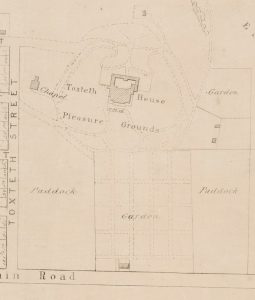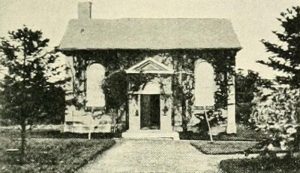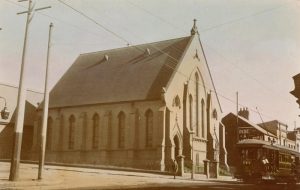Josiah Slater was one of George Allen’s most trusted servants on the Toxteth Park Estate. When he died on 17 April 1890 his residence was Elim. Dating from ca 1878, the two-storey freestanding building was probably built close to an earlier worker’s cottage in the Toxteth grounds. Elim is now 236 Glebe Point Rd. Its original name may be Biblical in origin.

A ‘baker’s boy’ from Macclesfield Cheshire, Josiah Slater was sentenced to 14 years for highway robbery and landed in Sydney in July 1834 on the transport ship Susan. The 18-year-old was assigned as a baker to George Allen. ‘It is my desire to make all my servants comfortable’, Allen wrote, ‘and in return I expect they will behave well’. A constant problem for Allen was his employees getting drunk, but Josiah was apparently a steady sober worker. He was rewarded with a cottage and other privileges, and on one occasion accompanied his teetotal employer and one of his daughters on a trip to Goulburn, probably as their coachman.
In 1840 Josiah was granted a ticket of leave on the understanding that he remain in George Allen’s employ, and four years later Allen recommended him for a conditional pardon. On 12 August 1847 he was granted his certificate of freedom. In March 1841 he had married Sarah Stowell, a free woman. This ceremony was performed by Anglican minister William Horatio Walsh, but most of the Slater children were baptised Methodist in the newly built Toxteth Park Chapel. Only Josiah jnr (1847-1929) and William (1849-1911) survived childhood. Nine-year-old Sarah jnr and 17-month-old Mary died in October 1852 followed a few weeks later by their seven-year-old brother John, suggesting they were victims of an infectious disease. They were buried in the Devonshire Street Cemetery, later the resting place of their mother in June 1855.
In 1861 freckle-faced small-statured William ran away from home; the next year his father offered a £5 reward after he took off again. The last news Josiah had of his youngest son was that, giving his name as Henry Williams, he had stayed with a farmer named Moxon near Penrith. William’s disappearance may have been connected with his father’s remarriage within a year of his mother’s death. Josiah’s new wife was Mary Wilson. Their son George Harpur Slater, born in 1861, in adult life was executor of his father’s will.

Mary Slater died on 4 May 1876 and was buried in Camperdown Cemetery. Three years later Josiah married his third wife, Anne Millman from Shropshire. Their daughter Annie was born in 1880, the same year Josiah purchased lot 22 of the Eglintoun subdivision at Glebe Point from van proprietor William Henry Tanner. After Josiah’s death in 1890 his widow remained at Elim for a short period before auctioneer and agent Piercy Augustus Ethell moved from around the corner in Toxteth Rd and used the house as an office. (Apart from regular real estate business, Ethell’s firm made money by subdividing Woodford, Hazelbrook, Blaxland and other Blue Mountains townships.) Anne Slater, who inherited the Eglintoun land, died aged 76 in 1916 and was buried with Josiah in Waverley Cemetery.
Joseph Slater
At some time in the early 1850s Josiah left Toxteth Park to set up business as a grocer cum coachman cum rent collector in Elizabeth St, Redfern. Another Slater ex-convict was soon working for George Allen, Josiah’s younger brother Joseph who had been sentenced to seven years at Nether Knutsford, Cheshire, in 1847. By then transportation to NSW had officially ceased, but England continued to send out ‘convict exiles’ who had served part of their term on hulks in their home country and understood that they would be granted a conditional pardon or ticket of leave when they landed in the colony. In 1849 the Rodney’s human cargo was not wanted in Launceston, Melbourne or Sydney and Joseph Slater was among those who ended up in Moreton Bay with a ticket of leave. After this was cancelled (along with dozens of others, on the grounds of absenteeism) Joseph made his way to Bathurst. Here he was in trouble again, for absenting himself from duty while in the employ of prominent physician, Richard Machattie.
Although Joseph had been dismissed from the Bathurst police force for being drunk on duty, he was taken on by George Allen, no doubt on assurances given by his brother. Joseph was part of the Toxteth Park household by 1859 when he was one of the hundreds who petitioned for a separate municipality for Glebe; he and Josiah endorsed auctioneer Thomas Ware Smart as Glebe’s candidate for the Legislative Assembly. In 1870 he pulled the lifeless body of fellow gardener James Lynch, his legs tied together, from a deep waterhole on Allen’s estate. A finding of suicide was brought by the jury at the inquest which was held in Allen’s house.

Before Joseph’s death on 16 August 1891 he had been renting various places in Glebe, the last in Mitchell St. The December 1892 funeral of his widow Elizabeth left from the Cowper St home of labourer Reuben Woolley. The couple were buried in the Old Methodist section at Rookwood.
The Scrivener Family
By 1895 Elim was occupied by Frederick Adam Scrivener and Elizabeth, née Johnston, and was the birthplace of their second son Edmond the next year.

Born at Liverpool NSW and educated at Sydney Grammar and King’s, Frederick Scrivener joined the Commercial Banking Company of Sydney at age 15. He worked in the Adelong branch before being promoted to Albury and then head office. An accomplished linguist, he was appointed in 1902 to manage the bank’s London branch and moved the family there. His older son, Rupert, a champion schoolboy rower, was on holiday in England while working as a mining engineer in Alaska when war was declared in 1914. Rupert was reputed to be the only officer in his regiment to escape unhurt in the Dardanelles campaign.
The Morison Family
During the tenure of the next occupants Elim was renamed Keewatin, suggesting a Canadian connection. In 1852 engineer David Morison migrated with his family from Wiltshire, England, after he was involved in failed industrial action there. By 1866 he, his wife and a consumptive teenage daughter had died. All were buried in the Devonshire Street Cemetery and their remains later reinterred at Rookwood. In 1869, third son, engineer David Morison jnr moved from Balmain to Glebe with Esther (‘Easter’), née Loutit. By 1900 they had settled at 200 Glebe Point Rd (renumbered 236 in 1907).
The Morisons were devout Methodists. David worshipped regularly at the Glebe Road Methodist Church, teaching Sunday School and acting as a trustee. His son William, a shorthand teacher, formed a Glebe branch of the Christian Endeavour Movement and was later elected as that organisation’s Australasian President. He taught Glebe beginners shorthand at night and was a champion lacrosse player. A founder of Morison Bros flour and produce merchants, William spent much of his adult life in Brisbane looking after the firm’s interests there. His brother Robert James, a salesman, also relocated to Queensland. Their sister was Jane Isabel Margaret, known as ‘Jeanie’.
In 1909 Jeanie Morison married Customs clerk William Walton King; William Morison King was born at Keewatin the next year. (In 1924 William Walton King was called to an inquiry to give eyewitness testimony of the crash of the ferry Kareela into the P&O wharf at Circular Quay, when two women and a baby were killed.)
Esther Morison died at Keewatin in April 1924 and was buried with her husband, who had predeceased her in March 1914, in the Presbyterian section at Rookwood together with his parents and sister. Jeanie and William Walton King remained in Keewatin until the late 1920s after which the house, like others in the suburb, was sublet into flats.
Lyn Collingwood
Local historian
Sources:
Allen, George Wigram Papers, Mitchell Library MSS 477/5;
Ancestry.com per Rodney Hammett;
Dyster, Barrie Servant & Master; NSW cemetery records;
NSW electoral rolls;
NSW Police Gazette;
NSW registry of births, deaths, marriages;
NSW State Records;
Sands Directories;
Trove website.









There are no comments yet. Please leave yours.